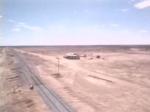

John Grant, a young Englishman, teaches in Tiboonda, a tiny railway junction on the far western plains of New South Wales. He sets off to spend his summer vacation in Sydney but doesn't make it beyond Bundanyabba, a nearby mining town known as 'the Yabba'. Stranded in town after losing all his money in a two-up game, he finds himself engulfed by the Yabba's claustrophobic, nightmarish, beer-fuelled stupor, an atmosphere compounded of repressed sexuality, squalid violence, and the sinister mateship of the locals. After being sexually assaulted by the town's alcoholic doctor, he attempts to hitchhike out of the town but is brought back by a truckie. In anger, he tries to shoot the doctor but ends up only shooting himself. After discharging himself from the hospital, Grant takes the train back to Tiboonda, resigned to another year of teaching.
'G’day. Welcome to the Yabba. Just passing through?
'It’s the best little town in the world. Things a bit grim? Chin up.
'John Grant is well-read, but an outback misadventure strands him—cashless and jobless—in a harsh and remote Aussie outpost, Bundanyabba.
'So, he makes new ‘mates’: they’re quick with a drink, but with every scull a dark violence lurches forward. Are these blokes fair dinkum, or is there something more sinister at the heart of this little Aussie town?
'On our Beckett Theatre stage, the entire world of Wake in Fright is conjured by the always-evocative Zahra Newman (The Book of Mormon) accompanied by a sonic assault from art-electronica band, friendships. Under the direction of Declan Greene, Kenneth Cook’s iconic work of Australian Gothic horror is felt in the flesh. Bring sunscreen, buy a beer and wear your ear plugs.
'Once we pierce the Yabba’s ocker veneer, you better be ready for the explosive brutality pent up inside.'
Source: Malthouse Theatre.
'A film and television historian is retracing the steps of a cult classic Australian movie ahead of it being given a high-definition makeover.'
'The seminal Australian film Wake in Fright (Ted Kotcheff, 1971) opens with a sweeping, circular pan around a desert landscape. It begins in silence, briefly focussed on a small house next to a railway track, but the camera soon moves on, curving around to the right, taking in an unending dusty expanse of yellow earth and pale blue, cloud dappled sky in all directions. The disorienting pan of the desert, the awareness of temporality as the simple shot goes on, work to bodily involve the viewer. The stillness of the landscape, contrasted with the steady movement of the camera, creates a feeling of presence in the scene – the spectator’s gaze roves over the landscape, taking it in and experiencing the isolation and solitude as if they were standing in it. The familiarity of the ‘outback landscape’, an archetypal image of Australia, also stirs affective responses in the Australian spectator, reminding them of their ‘closeness’ to the film’s eerie locality. ‘This is who you are to the world’, the film seems to say. This closeness, combined with the camera work which positions the viewer ‘in’ the desert, renders this scene extremely bodily – the spectator is pushed against the landscape, invited to feel the heat and dry stillness of the outback, as well as the isolation, before any plot or characters are introduced. Thus, we are invited to experience the film sensorily before we engage with it cerebrally, aligning with the hopes of director Ted Kotcheff, who “wanted people to watch the film and be sweating”. (Introduction)
'In his 2006 thesis, “‘Staying Bush’ – A Study of Gay Men Living in Rural Areas”, author Edward Green described his subject as the “largely hidden and untold story of gay men living in rural areas”. That was a pivotal year for gay men living in the bush, with Australian television broadcasters platforming two of their stories. In the space of one 12-month period, this cohort went from “hidden and untold” to prime time. From as early as 1989, rural politician Bob Katter had been declaring that he would “walk to Bourke backwards if the poof population of North Queensland is any more than 0.001 per cent”. Analysing media and popular culture, this article explores the visibility and portrayal of rural gay men in Australia prior to and after 2006. In spite of Katter’s minuscule population estimates, the rural gay cohort continues to defy assumptions.' (Publication abstract)